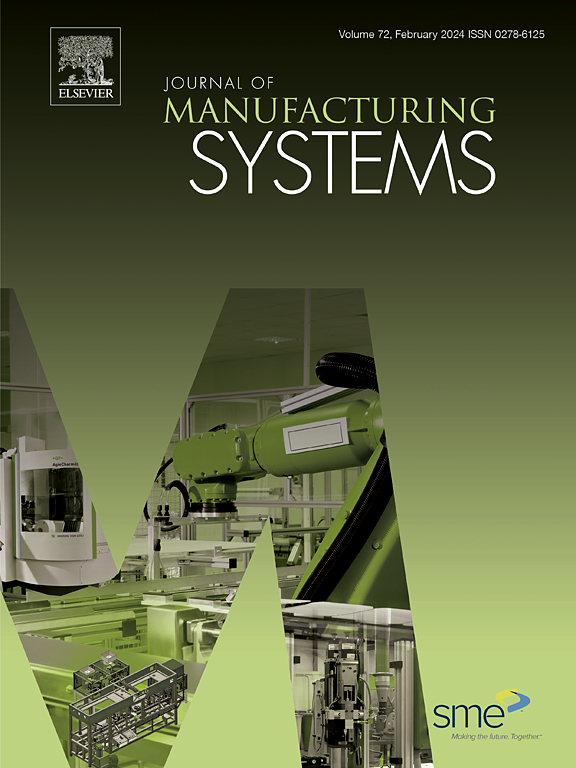Deposition sequence optimization for minimizing substrate plate distortion using the simplified WAAM simulation
IF 14.2
1区 工程技术
Q1 ENGINEERING, INDUSTRIAL
引用次数: 0
Abstract
Wire arc additive manufacturing (WAAM) is a viable alternative to conventional machining or other additive manufacturing technologies, especially for the production of large, thin-walled components. However, finding the optimal deposition sequence for a minimal substrate plate distortion is challenging due to the vast number of possible sequences. The present study tackles this challenge by exploring three distinct objective functions for predicting distortion using the simplified WAAM simulation (SWS) – a semi-analytical model for the time-efficient estimation of thermal histories in WAAM parts. Using the SWS together with three temperature-based objective functions, distortion scores were calculated for each deposition sequence of a four-sectioned wall geometry. A subset of deposition sequences was then simulated using an experimentally validated thermomechanical finite element (FE) simulation. The correlation between the simulated distortion from the FE model and the distortion score from each objective function was analyzed. The results implied a strong and definitive statistical correlation between the substrate plate distortion and one particular objective function which considers the thermal eccentricity. Subsequently, the wall geometry, together with an additional A-shaped geometry, was manufactured using the best, the worst, and a third deposition sequence. After the WAAM process, the substrate plate distortions were measured using a 3D scanner. The scan results validated the prior optimization, indicating the highest distortion for the worst sequence, the lowest distortion for the best sequence, and a level of distortion in between those extremes for the third sequence. The findings of this article can be utilized for the preliminary selection of deposition sequences of WAAM parts.
利用简化的WAAM模拟优化沉积顺序以减少基板畸变
电弧增材制造(WAAM)是传统机械加工或其他增材制造技术的可行替代方案,特别是对于大型薄壁部件的生产。然而,由于可能的序列数量众多,寻找最小基板变形的最佳沉积序列是具有挑战性的。本研究通过探索使用简化WAAM模拟(SWS)预测变形的三个不同的目标函数来解决这一挑战,SWS是一种半解析模型,用于快速估计WAAM部件的热历史。利用SWS和三个基于温度的目标函数,计算了四段壁面几何形状的每个沉积序列的变形分数。然后使用实验验证的热机械有限元(FE)模拟模拟沉积序列的子集。分析了有限元模型的模拟失真与各目标函数的失真评分之间的相关性。结果表明,基材变形与考虑热偏心率的特定目标函数之间存在强烈而明确的统计相关性。随后,采用最佳、最差和第三种沉积顺序制造了壁几何形状以及额外的a形几何形状。在WAAM工艺后,使用三维扫描仪测量基板变形。扫描结果验证了先前的优化,显示了最差序列的最高失真,最佳序列的最低失真,以及介于这两个极端之间的第三个序列的失真水平。本文的研究结果可用于WAAM零件沉积顺序的初步选择。
本文章由计算机程序翻译,如有差异,请以英文原文为准。
求助全文
约1分钟内获得全文
求助全文
来源期刊

Journal of Manufacturing Systems
工程技术-工程:工业
CiteScore
23.30
自引率
13.20%
发文量
216
审稿时长
25 days
期刊介绍:
The Journal of Manufacturing Systems is dedicated to showcasing cutting-edge fundamental and applied research in manufacturing at the systems level. Encompassing products, equipment, people, information, control, and support functions, manufacturing systems play a pivotal role in the economical and competitive development, production, delivery, and total lifecycle of products, meeting market and societal needs.
With a commitment to publishing archival scholarly literature, the journal strives to advance the state of the art in manufacturing systems and foster innovation in crafting efficient, robust, and sustainable manufacturing systems. The focus extends from equipment-level considerations to the broader scope of the extended enterprise. The Journal welcomes research addressing challenges across various scales, including nano, micro, and macro-scale manufacturing, and spanning diverse sectors such as aerospace, automotive, energy, and medical device manufacturing.
 求助内容:
求助内容: 应助结果提醒方式:
应助结果提醒方式:


